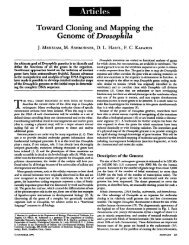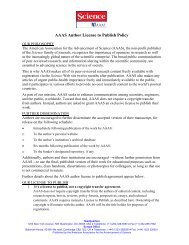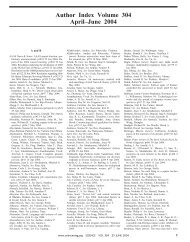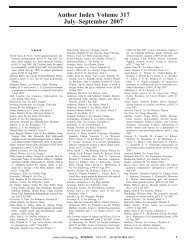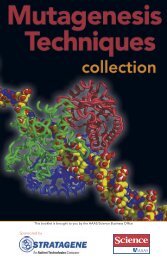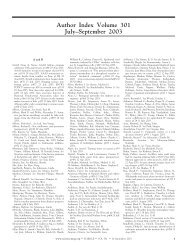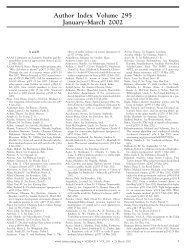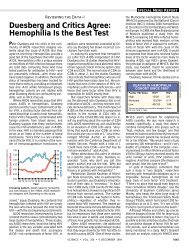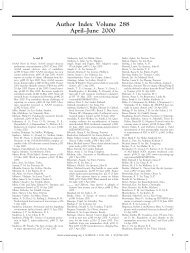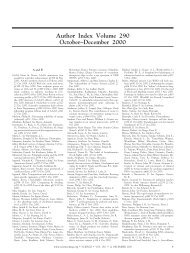Chinese Academy of Sciences (PDF) - low res version
Chinese Academy of Sciences (PDF) - low res version
Chinese Academy of Sciences (PDF) - low res version
You also want an ePaper? Increase the reach of your titles
YUMPU automatically turns print PDFs into web optimized ePapers that Google loves.
CREDIT: (FROM TOP) FROM THE HEFEI INSTITUTES OF PHYSICAL SCIENCE, CAS;<br />
FROM THE UNIVERSITY OF SCIENCE AND TECHNOLOGY OF CHINA<br />
Research CAS/In Focus<br />
The Experimental Advanced Superconducting Tokamak (EAST)<br />
Chemistry<br />
Over the past decade, CAS has worked hard to develop its <strong>res</strong>earch capacity<br />
in chemistry. A group from USTC, fol<strong>low</strong>ing the demonstration <strong>of</strong><br />
single-molecule magnetism through molecular manipulation (13), succeeded<br />
in integrating two functions into one molecule (14). In addition, through<br />
<strong>res</strong>onant tuning <strong>of</strong> molecular states by nanocavity plasmons, they discovered<br />
an unusual molecular electroluminescence at the nanoscale level (15).<br />
These findings provide new insights into the functioning <strong>of</strong> single-molecule<br />
devices and nanoscale optoelectronic integration.<br />
At a supramolecular level, advances in understanding the driving forces<br />
behind the formation <strong>of</strong> nanoarchitectu<strong>res</strong> has enabled the rational design<br />
<strong>of</strong> nano-patterned, hierarchical molecular assemblies, which have been<br />
further used to investigate surface host-guest chemistry, surface chirality,<br />
molecular electrochemistry, and other fundamental physiochemical properties<br />
(16–18).<br />
CAS scientists have made significant<br />
prog<strong>res</strong>s in studying the catalytic performance<br />
<strong>of</strong> dual catalysts (19) and in<br />
understanding the interfacial confinement<br />
(20) and morphological effects<br />
(21) <strong>of</strong> some catalytic systems. CAS<br />
chemists have also achieved a series <strong>of</strong><br />
breakthroughs in molecular electronics.<br />
Synthesis and controllable assembly<br />
<strong>of</strong> new conjugated molecular systems<br />
(e.g., graphdiyne) have led to organic<br />
semiconductors (p- and n-types) with<br />
high mobility (>1.0 cm 2 .V -1 .S -1 ) (22, 23)<br />
and photovoltaic materials with high en-<br />
ergy con<strong>version</strong> efficiency (>7.0%) (24,<br />
25). Moreover, the interfacial properties<br />
Hefei Synchrotron Light Source<br />
within organic field-effect transistors have been investigated and new technologies<br />
have been developed for <strong>low</strong>-cost, large-area, and flexible organic<br />
circuits (26).<br />
Nanoscience and Nanotechnology<br />
CAS has pioneered and played a leading role in nanoscience <strong>res</strong>earch in<br />
China. With its strategic deployment in the fields <strong>of</strong> nanomaterials, nanocharacterization,<br />
nanodevices, and nanobiomedicine, CAS has achieved<br />
significant prog<strong>res</strong>s in revealing fundamental aspects <strong>of</strong> the novel properties<br />
<strong>of</strong> a wide range <strong>of</strong> engineered nanostructu<strong>res</strong>. For examples, CAS<br />
<strong>res</strong>earchers have developed a series <strong>of</strong> nanostructu<strong>res</strong> and multifunctional<br />
nanodevices based on carbon nanotubes (27–30); graphene (31, 32);<br />
graphdiyne (33); nanocrystalline copper with superplastic extensibility (34,<br />
35), ultrahigh strength, and high electrical conductivity (36, 37); nanostructu<strong>res</strong><br />
for high density memory devices (38) and high efficiency solar cells<br />
(39); and drug delivery systems for cancer<br />
therapies (40).<br />
Significant prog<strong>res</strong>s has been made<br />
in advancing technology transfer in the<br />
energy, health, environmental, and manufacturing<br />
sectors. A series <strong>of</strong> superhydrophobic<br />
surfaces based on micro- and<br />
nanostructu<strong>res</strong> have been fabricated<br />
(41, 42), leading to the invention <strong>of</strong> the<br />
nanomaterial-based green printing plate<br />
technology which has already been applied<br />
successfully in the printing industry.<br />
A nanocoating technology using room<br />
temperature vulcanization with silicone<br />
rubber capable <strong>of</strong> dirt-flashover <strong>res</strong>istance<br />
has been developed and applied<br />
11



